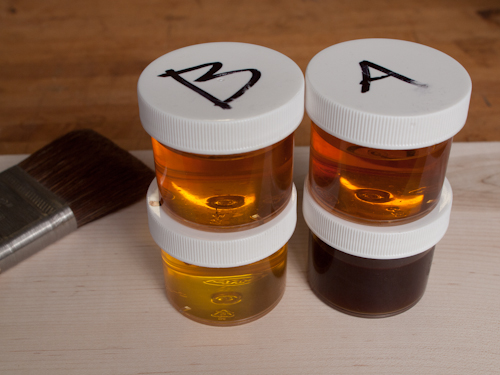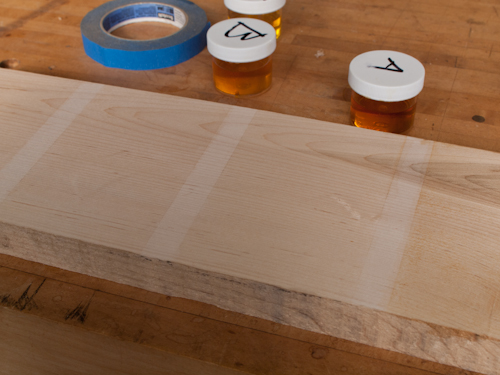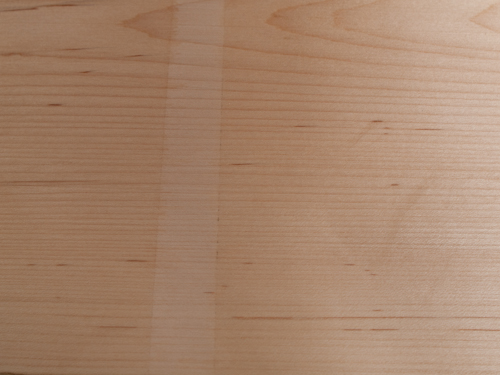 We package and sell dewaxed shellac under the BT&C brand. Regular BT&C shellac we fly in from India and while we don't at the moment retail it ourselves you will find it at retailers all over the US. Tiger Flakes, which is also a BT&C product, is refined in Germany, and we both retail and wholesale that. We package and sell dewaxed shellac under the BT&C brand. Regular BT&C shellac we fly in from India and while we don't at the moment retail it ourselves you will find it at retailers all over the US. Tiger Flakes, which is also a BT&C product, is refined in Germany, and we both retail and wholesale that.
From a retail standpoint shellac flakes are a fussy product. First of all it's a great finish and sticks to everything. But how fast shellac dissolves is a function of the age of shellac, how it was stored, the quality of the alcohol used, the size of the flakes, and agitation. We have no control over the last three parameters but we have spent years upping our game on the first two. So when you get a bag of shellac from us it's in a fairly heavy bag that is a good oxygen barrier, and it's got an oxygen absorber in it. This seems to help. In addition we try not to keep it around and fly in small quantities as we need them from India or from our Tiger Flake supplier .
We test every batch of shellac that goes out of here. We make sure it dissolves easily and every bag is batch dated so we can keep track of what's going on. So after getting a query from a customer about the differences between the various types of Tiger Flakes we stock I realized that I've got these little samples of shellac in all the colors and doing a quick test wouldn't be that hard.
"Cut" is the term used to describe how thin or thick the shellac to alcohol mix is. A 2lb. cut, or two pounds of shellac dissolved in a gallon of alcohol is pretty standard but a quick calculation suggests that my samples are about 1.5 lb cut. A little thin for a lot of build-up but reasonable.
 All the samples in the test were Tiger Flakes, just because that's what we had from our most recent packing. We stock four types of Tiger Flakes (in order of color density): Super-Blond, Blond, Amber, and Garnet. I applied a fairly heavy coat of each type of shellac to a freshly planed board of maple and took a look at the results. All the samples in the test were Tiger Flakes, just because that's what we had from our most recent packing. We stock four types of Tiger Flakes (in order of color density): Super-Blond, Blond, Amber, and Garnet. I applied a fairly heavy coat of each type of shellac to a freshly planed board of maple and took a look at the results.
Remember two things - there is only one or two heavy coats on this wood, maple absorbs very little finish, and a proper French polish would have far, far more buildup and show off the colors better. Even a regular shellac finish would have more buildup than these samples. What is interesting to me is how even a thin coat of super-blond adds a little color to the maple, but the main difference between the colors is a little bit of extra color definition in the pores of the wood. This is what makes grain pop in a finish.
 My conclusion: If you are just planning a wash coat of shellac as a primer, using blond is less expensive than super-blond and should be almost indistinguishable. If you are planning a French polish over distinctly colored marquetry super blond might keep your materials less yellow, but if you are doing woodtones - blond might be just as good. If you want character in your finish without going crazy, especially if you aren't French polishing, garnet will pop the grain nicely and isn't nearly as dark a finish as the flakes might suggest. Amber is a good choice if you want the piece to look shellaced as if the finish had age in it. My conclusion: If you are just planning a wash coat of shellac as a primer, using blond is less expensive than super-blond and should be almost indistinguishable. If you are planning a French polish over distinctly colored marquetry super blond might keep your materials less yellow, but if you are doing woodtones - blond might be just as good. If you want character in your finish without going crazy, especially if you aren't French polishing, garnet will pop the grain nicely and isn't nearly as dark a finish as the flakes might suggest. Amber is a good choice if you want the piece to look shellaced as if the finish had age in it.
Note: While our bags are fairly decent oxygen barriers and they have the absorber, and they reseal, store the bags in a sealed glass container, kept in the fridge. Super-blond - has the shortest shelf life in flakes - garnet the longest.
|
 Joel's Blog
Joel's Blog Built-It Blog
Built-It Blog Video Roundup
Video Roundup Classes & Events
Classes & Events Work Magazine
Work Magazine


 We package and sell dewaxed shellac under the BT&C brand. Regular BT&C shellac we fly in from India and while we don't at the moment retail it ourselves you will find it at retailers all over the US.
We package and sell dewaxed shellac under the BT&C brand. Regular BT&C shellac we fly in from India and while we don't at the moment retail it ourselves you will find it at retailers all over the US.  All the samples in the test were
All the samples in the test were  My conclusion: If you are just planning a wash coat of shellac as a primer, using blond is less expensive than super-blond and should be almost indistinguishable. If you are planning a French polish over distinctly colored marquetry super blond might keep your materials less yellow, but if you are doing woodtones - blond might be just as good. If you want character in your finish without going crazy, especially if you aren't French polishing, garnet will pop the grain nicely and isn't nearly as dark a finish as the flakes might suggest. Amber is a good choice if you want the piece to look shellaced as if the finish had age in it.
My conclusion: If you are just planning a wash coat of shellac as a primer, using blond is less expensive than super-blond and should be almost indistinguishable. If you are planning a French polish over distinctly colored marquetry super blond might keep your materials less yellow, but if you are doing woodtones - blond might be just as good. If you want character in your finish without going crazy, especially if you aren't French polishing, garnet will pop the grain nicely and isn't nearly as dark a finish as the flakes might suggest. Amber is a good choice if you want the piece to look shellaced as if the finish had age in it.
Oar put a nitrogen line at the bottom of a jar, add the shellac flake and run in the nitrogen for several minutes, remove the line with the nitrogen running and seal it up immediately.
Further, remember the alcohol contains dissolved air (nitrogen & oxygen) and the oxygen if it can will promote coloration and perhaps promote a reaction of the shellac with either itself or the oxygen.
I can't blame Joel for wanting to differentiate his product from all...it is what marketing has taught us all to do. But, I put all this unnecessary fussiness over shellac in the same category as the guy worrying about a few thousandths run-out on his bowl turning chuck...it just doesn't matter. It reminds me of the anal-retentive chef on Saturday Night Live way back...he could never accomplish anything for worrying about wrapping up the refuse.
Storage is an issue. temperature is an issue. Waxed shellac lasts lots longer than dewaxed shellac. As a retailer we can only try to make sure we get shellac to you in the best condition we can. THe wide range of experience shown in the comments demonstrates how hard it is to have a solid rule of thumb.